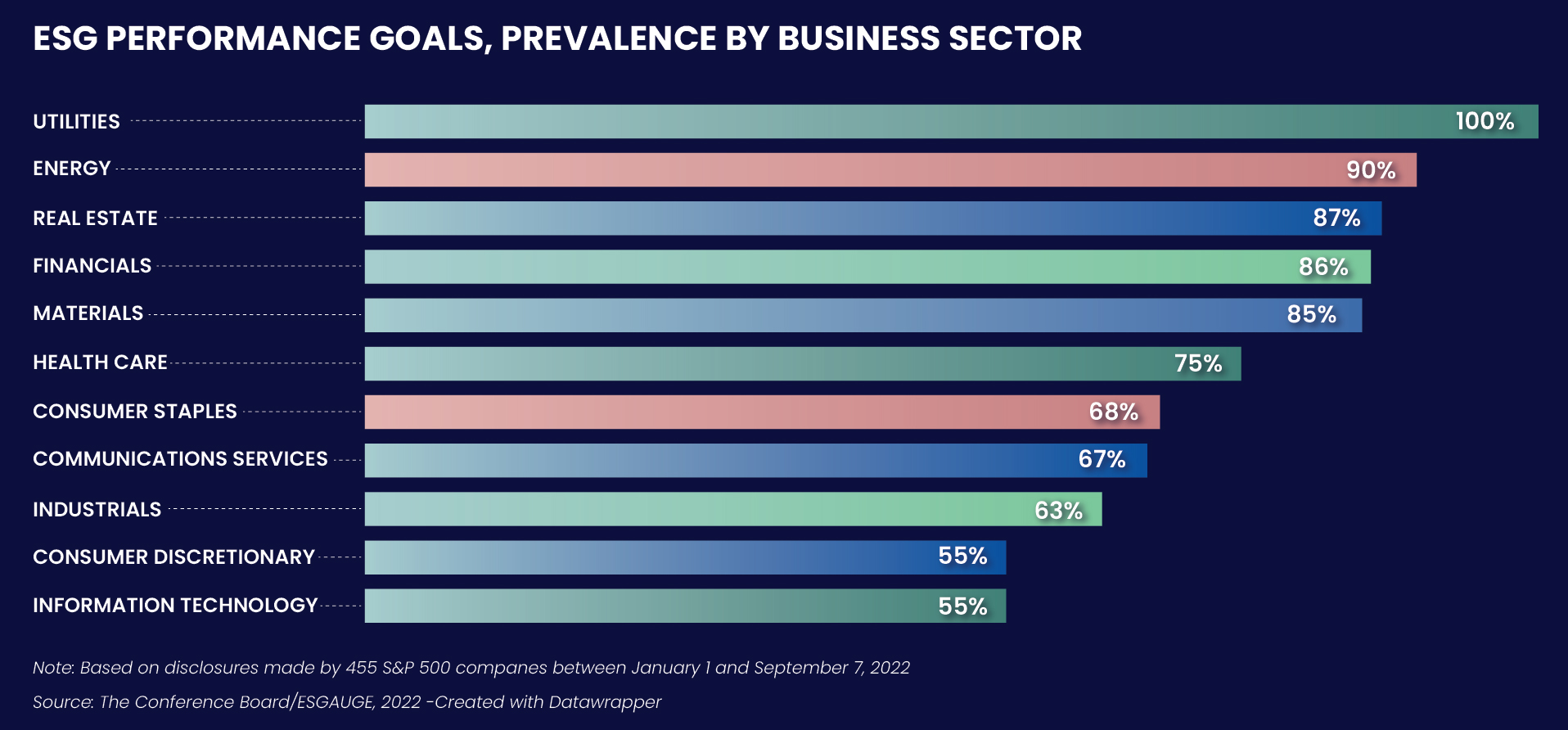
The adoption of environmental, social, and governance (ESG) metrics in executive compensation plans has continued to increase globally. In 2022, 77% of listed companies in Europe and North America incorporated ESG metrics into their annual or long-term incentive plans, an increase from 68% in the prior year. Notwithstanding its growing popularity, this form of ESG integration is still uncharted territory for many organizations, prompting questions about metric selection, implementation tactics, and why it’s all happening.

Which ESG metrics are being used and where?
The breadth of existing ESG-related issues has led to the inclusion of various ESG metrics in incentive plans, with social metrics being the most frequently used. For instance, WTW’s 2022 Global Report on ESG Metrics in Executive Plans states that 68% of companies integrate at least one human capital metric (e.g., DEI performance) in their remuneration packages. Other frequently used social metrics include employee engagement and succession/talent management. The WTW report further highlights that the prevalence of social metrics is a global phenomenon: around 80% of companies in Canada, Europe, and the UK—and 66% of the S&P 500—now incorporate social metrics in their executive incentive plans.
In comparison, WTW’s research reveals that 45% of companies incorporate at least one governance metric (e.g., compliance), while 40% use at least one environmental metric (e.g., carbon emissions reduction). However, regional differences are most notable for environmental metrics, which are incorporated by only 25% of the largest US companies—compared to roughly two-thirds of large European and UK-based firms.
It’s also important to note that the integration of ESG metrics in executive compensation varies significantly by industry. For instance, a Conference Board report titled “Linking Executive Compensation to ESG Performance”indicates that all utility firms and 90% of companies in the energy sector tie ESG performance to executive remuneration (see Figure 1 below).
Figure 1

In comparison, approximately only 50% of companies in the IT and consumer discretionary spaces do so. Moreover, the authors of the Conference Board report suggest that this difference may exist because companies in controversial sectors (on such topics as employee health and safety, or carbon footprint) are more inclined to prioritize ESG in executive compensation compared to those in less scrutinized ones.
Long-term focus: why it’s happening
While environmental metrics are least used overall, they are the most common measure in long-term incentive plans, typically focusing on decarbonization and energy transition. This may be due to the 2050 net zero commitments made by companies to align with the 2015 Paris Agreement, which aims to connect timing on long-term commitments and executive incentives to deliver on these commitments.
For example, Siemens has a 20% ESG performance modifier on the number of shares awarded, impacting executives in senior management and top management contract groups. Performance assessment is based on an internal ESG/Sustainability index determined annually by the Supervisory Board, with reduction of CO2 emissions, the number of training hours per employee, and customer Net Promoter Score (NPS) as ESG key performance indicators.
A 2021 Harvard Business Review article on compensation states that “by aligning executives’ financial incentives with company strategy, a firm can inspire its management to deliver superior results”. For instance, Flammer, Hong & Minor’s 2019 study finds that incorporating environmental and social metrics in executive compensation enables:
- An increase in long-term orientation and mitigation of corporate short-termism
- An increase in firm value
- An uptake in social and environmental initiatives
- A reduction in toxic emissions
- An increase in green innovations (patents)
Recommendations from the UN Principles for Responsible Investment (PRI)
The PRI underscores the importance of ESG metrics in executive compensation. For instance, it advocates for investors to outline a clear position in favor of incorporating ESG metrics into incentive plans. Investors are encouraged to prompt investee companies to systematically identify pertinent ESG factors and to escalate stewardship efforts for companies that fall into the following categories:
- Those who haven’t taken steps to integrate ESG criteria into their pay plans, especially when exposed to significant environmental and social risks.
- Those that incorporate ESG metrics but haven’t done so in a meaningful way. This includes an excessive focus on qualitative and vague measures, or using metrics that don’t align with the organization's ESG priorities.
- Those who lack transparency regarding the mechanisms in place or the impact on realized pay, preventing investors from adequately assessing the effectiveness of ESG-linked pay.
Investors care
Investors are the main stakeholders pushing for executive compensation to be linked to ESG performance metrics. A good example is global investment management firm AllanzGI, who has started voting against the pay policies of large European companies that fail to integrate ESG metrics in executive compensation plans. In 2024, they will vote against directors if companies do not set net zero targets and a viable strategy to achieve them.
Moreover, the connection between ESG in executive compensation and investor trust appear to be solidifying. In their 2020 study of institutional investors, Edelman found that 69% of US investors said that linking executive compensation to ESG performance targets positively impacts their trust in a company that they’ve invested in—or are considering investing in—a 17% increase from the previous year.

Into the future
The integration of ESG metrics into executive compensation is here to stay.
By holding executives accountable to ESG objectives through incentive plans, companies can mitigate corporate short-termism, fostering a culture that prioritizes longer horizons. They can also position themselves as trailblazers in corporate sustainability reporting, inspiring other firms to follow suit.
Are you linking ESG performance metrics to your incentive plans? Explore our ESG in Executive Compensation Research Note for a comprehensive overview, including key recommendations and best practices.

